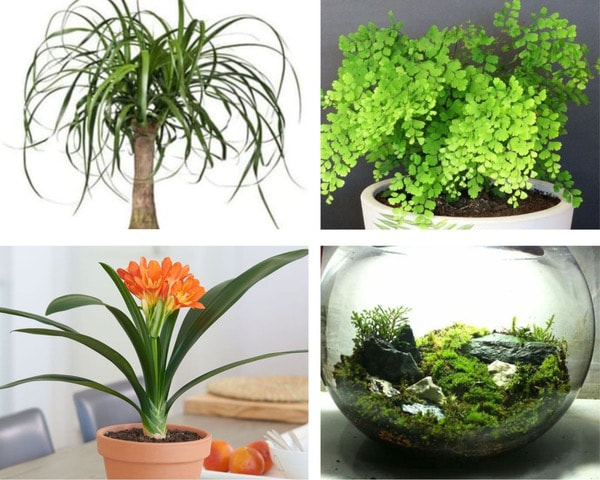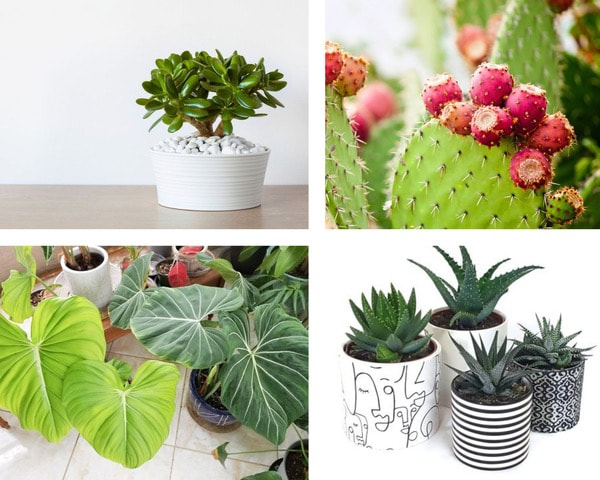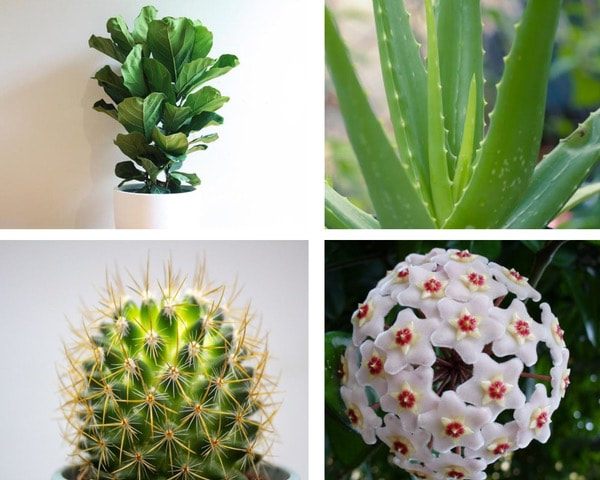Here’s a story designed for all the brown thumbs out there who love indoor plants. It probably isn’t necessary for me to say I am one. On both counts. I get the best advice, I follow the instructions religiously and faster than you (that would be my husband) can say “did you over water it?” it’s brown, drooping or dropping…and rapidly heading towards that big nursery in the sky.
If you watch enough reality TV shows these days (and who doesn’t?), indoor plants for decorating come a close second to twenty mis-matched cushions piled onto a bed or sofa.
And so, I’ve gone on a hunt for plants that apparently even I will find hard to murder and should last longer than a couple of months. My long-suffering local nurseryman and numerous green-thumbed friends have consulted and given their opinions – let’s see what you think.
Obviously, growing conditions will differ twixt northern and southern hemispheres, but the principles should still apply when you consider they are indoor plants.
I’ll give them all a go and if it’s not too embarrassing, I’ll keep you up to date with progress on the Grandparents Day Magazine Facebook page!
If you watch enough reality TV shows these days (and who doesn’t?), indoor plants for decorating come a close second to twenty mis-matched cushions piled onto a bed or sofa.
And so, I’ve gone on a hunt for plants that apparently even I will find hard to murder and should last longer than a couple of months. My long-suffering local nurseryman and numerous green-thumbed friends have consulted and given their opinions – let’s see what you think.
Obviously, growing conditions will differ twixt northern and southern hemispheres, but the principles should still apply when you consider they are indoor plants.
I’ll give them all a go and if it’s not too embarrassing, I’ll keep you up to date with progress on the Grandparents Day Magazine Facebook page!

Chinese Evergreen
It’s beautiful, but beyond its handsome exterior is a tough, forgiving houseplant. It can be tolerant to low light or inconsistent watering, especially in winter as long as it doesn’t stay wet for extended periods. It provides air-purifying powers through the winter season and looks fresh and green all year.
ZZ Plant
I was told this plant is virtually indestructible - in fact, will often do better if you leave it alone even after months of neglect. While this sounds like my ideal plant, I am not really re-assured. Since it can thrive in low-light conditions, the ZZ plant continues to look good under short winter days.
Moth Orchid
Orchid????? My Dad used to grow them and it was almost a fulltime job! But apparently, cultivating a moth orchid can be a breeze. While the moth orchid is happiest in a medium to brightly lit spot, it tolerates low light very well. Thanks to its preference toward a drier climate, we can enjoy its blooms without having to shower it with attention.
Snake Plant
Like the mis-matched and oddly-shaped cushions, this plant apparently adds an ‘architectural interest to any room’. It says phooey to low-light and drought, and insects are no match for the sturdy constitution of this houseplant that also has air-purifying benefits.
It’s beautiful, but beyond its handsome exterior is a tough, forgiving houseplant. It can be tolerant to low light or inconsistent watering, especially in winter as long as it doesn’t stay wet for extended periods. It provides air-purifying powers through the winter season and looks fresh and green all year.
ZZ Plant
I was told this plant is virtually indestructible - in fact, will often do better if you leave it alone even after months of neglect. While this sounds like my ideal plant, I am not really re-assured. Since it can thrive in low-light conditions, the ZZ plant continues to look good under short winter days.
Moth Orchid
Orchid????? My Dad used to grow them and it was almost a fulltime job! But apparently, cultivating a moth orchid can be a breeze. While the moth orchid is happiest in a medium to brightly lit spot, it tolerates low light very well. Thanks to its preference toward a drier climate, we can enjoy its blooms without having to shower it with attention.
Snake Plant
Like the mis-matched and oddly-shaped cushions, this plant apparently adds an ‘architectural interest to any room’. It says phooey to low-light and drought, and insects are no match for the sturdy constitution of this houseplant that also has air-purifying benefits.

Ponytail Palm
If you’re in search of a plant that will add a little flair but will also survive a winter with the heat cranked up, look no further. It stores a generous amount of water in its thick, textured trunk, making use of its reserves during periods of drought. Resilient in nature, the ponytail palm is the perfect way to add a festive feel to your home or desk.
Maidenhair Fern
Many varieties of fern don’t need much light because they’re used to growing on forest floors, completely shaded by a canopy of trees. However, while they can tolerate low levels of light, they demand high humidity and like to be watered and misted frequently, so I’m a bit concerned about my chances with this one. The delicate, lacy leaves will be happy in a spot offering indirect light for at least part of the day.
Clivia
Many of us who live in older houses have rooms that are chilly and don’t get a lot of sunlight. I’m told this may be an ideal match. It doesn’t mind a drafty home, and the vibrant colours will brighten up a chilly space. Another attraction: Clivia like to be kept on the dry side, so I don’t need to (remember to) water them every day.
Moss Terrarium
I truly adore the look of a Moss Terrarium and an enormous one that I received for my 21st birthday was a treasured possession. Luckily for it, my Mother took responsibility for its care and it lasted for many years. I’m certainly not game to try and build one for myself, but there are many fabulous websites, YouTube instructions and classes to help you make yours. Ideal plants for covered terrariums are mosses, ferns, and fern allies.
If you’re in search of a plant that will add a little flair but will also survive a winter with the heat cranked up, look no further. It stores a generous amount of water in its thick, textured trunk, making use of its reserves during periods of drought. Resilient in nature, the ponytail palm is the perfect way to add a festive feel to your home or desk.
Maidenhair Fern
Many varieties of fern don’t need much light because they’re used to growing on forest floors, completely shaded by a canopy of trees. However, while they can tolerate low levels of light, they demand high humidity and like to be watered and misted frequently, so I’m a bit concerned about my chances with this one. The delicate, lacy leaves will be happy in a spot offering indirect light for at least part of the day.
Clivia
Many of us who live in older houses have rooms that are chilly and don’t get a lot of sunlight. I’m told this may be an ideal match. It doesn’t mind a drafty home, and the vibrant colours will brighten up a chilly space. Another attraction: Clivia like to be kept on the dry side, so I don’t need to (remember to) water them every day.
Moss Terrarium
I truly adore the look of a Moss Terrarium and an enormous one that I received for my 21st birthday was a treasured possession. Luckily for it, my Mother took responsibility for its care and it lasted for many years. I’m certainly not game to try and build one for myself, but there are many fabulous websites, YouTube instructions and classes to help you make yours. Ideal plants for covered terrariums are mosses, ferns, and fern allies.

Jade Plant
A lot of plants don't really like the combination of cold air with hot radiator air in the winter month and vice versa, however some plants can tolerate it. It also doesn’t require much water and can thrive with a watering once every three weeks. This plant looks like a miniature tree, so it will introduce a refreshing burst of greenery to your home, even when the trees outside are leafless.
Christmas Cactus
In the northern hemisphere, this plant is typically propagated for sale before Thanksgiving, but its pretty red and pink blooms hint at spring. I’m assured it’s undeniably low-maintenance. I found this great quote by Barbara Pierson, a nursery manager. “They range in color, thrive on neglect, and can be kept indoors year-round or moved outside for the summer in full shade.”
Philodendrons
These plants only need to be watered once every two weeks or so. What’s the secret to knowing if your giant monstera plant is thirsty? Pick up the plant and get familiar with its typical weight. Sometimes water evaporates much faster or much slower depending on the room temperature. So, if the plant feels heavy but hasn't been watered in two weeks, the soil is probably still very wet and watering it again will only cause it harm.
Succulents
We all love these – even the little plastic ones on restaurant tables. They come in a wide array of colors and styles, so you can mix and match to create a unique grouping. It’s advised to almost not water your succulents throughout the winter months. Some succulents may continue to grow during this time, while others will wait at a standstill until spring. When warmer weather hits, you can resume regular (yet still infrequent) watering.
A lot of plants don't really like the combination of cold air with hot radiator air in the winter month and vice versa, however some plants can tolerate it. It also doesn’t require much water and can thrive with a watering once every three weeks. This plant looks like a miniature tree, so it will introduce a refreshing burst of greenery to your home, even when the trees outside are leafless.
Christmas Cactus
In the northern hemisphere, this plant is typically propagated for sale before Thanksgiving, but its pretty red and pink blooms hint at spring. I’m assured it’s undeniably low-maintenance. I found this great quote by Barbara Pierson, a nursery manager. “They range in color, thrive on neglect, and can be kept indoors year-round or moved outside for the summer in full shade.”
Philodendrons
These plants only need to be watered once every two weeks or so. What’s the secret to knowing if your giant monstera plant is thirsty? Pick up the plant and get familiar with its typical weight. Sometimes water evaporates much faster or much slower depending on the room temperature. So, if the plant feels heavy but hasn't been watered in two weeks, the soil is probably still very wet and watering it again will only cause it harm.
Succulents
We all love these – even the little plastic ones on restaurant tables. They come in a wide array of colors and styles, so you can mix and match to create a unique grouping. It’s advised to almost not water your succulents throughout the winter months. Some succulents may continue to grow during this time, while others will wait at a standstill until spring. When warmer weather hits, you can resume regular (yet still infrequent) watering.

Fiddle Leaf Fig Tree
The fiddle leaf fig tree should be watered once every two weeks during the spring/summer growing season, but only needs water about once a month during winter. Also keep in mind that water evaporates more slowly in a chilly room than a hot one, so pay attention to whether the room is drafty and damp or dry and hot.
Aloe
If your house runs dry in the winter, but you’re too busy to water your plants regularly (let alone turn on a humidifier for them), then aloe is a great choice. This hardy succulent can store water in its sculptural leaves, allowing it to go long stretches between waterings. The only downside is that this plant won’t give you any visual clues if it’s parched —it won’t wilt! While this desert plant can handle a dry environment, it also loves to sunbathe, so it needs to be set near a window that gets plenty of light.
Cacti and Desert Plants
These are the plants for the ‘warm’ home! They love dry air and hot environments because that's where they are naturally from. And because many deserts are known to get chilly at night, some varieties of desert plants can handle the cold and go into winter dormancy. They'll drop their leaves but appreciate the snooze from the growing season.
Wax Plant
This plant is also known as ‘hoya’. It has thick waxy leaves and rope-like stems that allow them to take hot temperatures by storing water in their succulent plant parts. By reserving water in this way, the wax plant is always prepared for an unexpected drought. The hoya’s cascading leaves look stunning when suspended in a hanging woven basket, and if you forget to water it for a few weeks, this forgiving plant will bounce back quickly without getting brown leaves.
The fiddle leaf fig tree should be watered once every two weeks during the spring/summer growing season, but only needs water about once a month during winter. Also keep in mind that water evaporates more slowly in a chilly room than a hot one, so pay attention to whether the room is drafty and damp or dry and hot.
Aloe
If your house runs dry in the winter, but you’re too busy to water your plants regularly (let alone turn on a humidifier for them), then aloe is a great choice. This hardy succulent can store water in its sculptural leaves, allowing it to go long stretches between waterings. The only downside is that this plant won’t give you any visual clues if it’s parched —it won’t wilt! While this desert plant can handle a dry environment, it also loves to sunbathe, so it needs to be set near a window that gets plenty of light.
Cacti and Desert Plants
These are the plants for the ‘warm’ home! They love dry air and hot environments because that's where they are naturally from. And because many deserts are known to get chilly at night, some varieties of desert plants can handle the cold and go into winter dormancy. They'll drop their leaves but appreciate the snooze from the growing season.
Wax Plant
This plant is also known as ‘hoya’. It has thick waxy leaves and rope-like stems that allow them to take hot temperatures by storing water in their succulent plant parts. By reserving water in this way, the wax plant is always prepared for an unexpected drought. The hoya’s cascading leaves look stunning when suspended in a hanging woven basket, and if you forget to water it for a few weeks, this forgiving plant will bounce back quickly without getting brown leaves.
